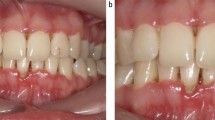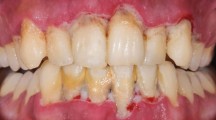Key Points
-
Halitosis is a common concern for many people.
-
The main causes of halitosis are known to be periodontal disease and tongue coating.
-
This report describes tonsilloliths as a cause of halitosis.
Abstract
Halitosis, or bad breath, is a common concern for many people. The main causes are known to be periodontal disease and tongue coating. We present a case of an incidental tonsillolith occurrence, which was a halitosis-inducing factor. Our results show that tonsilloliths should be considered as a possible cause of halitosis.
Similar content being viewed by others
Case report
A 25-year-old Japanese male student came to the Breath Odour Clinic of Kyushu Dental College (Kitakyushu, Japan) in June 2002 complaining that something had caught in his throat, which he also considered might have been the cause of breath odour. He was active in musical activities, mainly as a vocalist at his university, and often noticed the sensation of something caught in his throat, especially after singing. The patient had not previously undergone a breath odour test. On oral examination, no dental caries were observed and his periodontal tissue condition was good, while the amount of tongue coating was light with less than one third of the tongue dorsum surface covered. Resting and stimulated salivary flow rates were normal. He was unaware of any other systemic disorders that could affect oral malodour, and had no history of periodontal treatment or antibiotic medication during the previous 3 months.
Malodour assessment
A standard malodour assessment was performed as follows. Prior to the appointment for odour assessment, the patient was asked to refrain from:
-
1
consuming food containing onions, garlic, or hot spices for 48 hours;
-
2
drinking alcohol or smoking tobacco for 12 hours;
-
3
performing oral hygiene, including tooth brushing, interdental and tongue cleaning or mouth rinsing for 2 hours;
-
4
eating or drinking for two hours;
-
5
applying scented cosmetics or after-shave lotions on the morning of the examination, which was conducted at 10 am.
A gas chromatograph (G2800; Yanako, Kyoto, Japan) was used for the test, during which the patient was instructed to close his mouth for one minute prior to the sample collection, while sitting in an upright position. A syringe with a Teflon tube was used, and mouth air (10 ml) was aspirated with the valve closed. During the sample collection, the patient held his breath to avoid contamination by lung air.
The main components of oral malodour in humans are volatile sulphur compounds (VSC), including H2S, CH3SH, and (CH3)2S.1 In the present patient, an H2S concentration of approximately 1.2 ng/ 10 ml was detected. Furthermore, an organoleptic test (OLT) (a method used for direct sniffing of expelled mouth air) was performed by three trained dentists. For the OLT, the patient was asked to remain quiet and maintain a closed mouth for a period of 30 seconds. He was then requested to exhale through the mouth with moderate force into a sampling bag (GL Science Inc., Japan) for two to three seconds to prevent dilution of the odour with lung and room air. OLT scores were estimated for malodorous strength on a scale of 0 to 5,2 and the final score of the present patient was recorded as grade 2 (slight, but clearly noticeable odour).
During the oral examination, two white tonsilloliths were observed to the right of the tonsillar crypts (Figs 1 and 2) and, following the odour tests, a total of four were removed without pain using college pliers. Immediately after their removal, a second odour test was performed using gas chromatography and an H2S concentration of 0.4 ng/10 ml was detected, which was approximately one third of the value in the first test. Considering that the reliability of the gas chromatography method used had a standard deviation (SD) lower than 0.1 ng/10ml, this reduction (0.8 ng/10ml) in H2S level was considered to be significant (though not within the realms of test, re-test error). The test was performed again at 10 am the next day using the standardised methods described above, during which an H2S concentration of 0.3 ng/10ml was detected and the OLT score was recorded as 0. To our knowledge, no direct evidence of the presence of tonsilloliths as a halitosis-inducing factor has been reported, as most dental researchers have concluded that they do not appear to be a significant source of bad breath.3 Thus, this is the first report of tonsilloliths as a cause of halitosis. The present patient had been concerned about his breath odour, even though it was only slightly malodorous and, when the cause of halitosis was revealed, he expressed his relief in knowing the cause.
Discussion
In the present case patient, we found that tonsilloliths might have been a halitosis-inducing factor. It is thought that tonsilloliths arise either as a result of chronic infection leading to calcification of the contents of follicular cysts, or from calcification of food debris, and a previous study found tonsilloliths to be composed of phosphate and carbonate salts of calcium. 4
Scant epidemiological information is currently available concerning the occurrence of tonsilloliths, though Weller reported 80 cases of tonsillar concretions from a total of 1,000 tonsil specimens.5 Therefore, it is possible that this case was an incidental finding. In general, since dentists are accustomed to examining the oral cavity, however, since they rarely examine the tonsil and pharynx area, the presence of a tonsillolith may be easily overlooked. We considered that breath malodour caused by a tonsillolith, as seen in the present case, could occur in younger individuals who demonstrate relatively favourable periodontal conditions without tooth decay. Further, it was speculated that such patients might be given a diagnosis of delusional halitosis, such as halitophobia, if the presence of a tonsillolith is not confirmed, causing them to become upset, and feel that their complaints were not accepted by the dentist. It is generally recognised that breath malodour can be sufficiently treated by treating periodontal diseases and tongue coating. However, dentists should also be aware that a tonsillolith may sometimes be the cause of breath malodour.
References
Tonzetich J, Johnson PW. Chemical analysis of thiol, disulfide and total sulphur content of human saliva. Arch Oral Biol 1977; 22: 125–131.
Rosenberg M., Kulkarni G V, Bosy A, McCulloch C A. Reproducibility and sensitivity of oral malodour measurements with a portable sulphide monitor. J Dent Res 1991; 70: 1436–1440.
Rosenberg M, Leib E. Experiences of an Israeli malodour clinic. In: Rosenberg M, ed. Bad breath: research perspectives. pp 137–148. Tel Aviv, Israel: Ramot Publishing – Tel Aviv University, 1995.
Gapany-Gapanavicius B. Peritonsillar abscess caused by a large tonsillolith. Ear Nose Throat J 1976; 55: 343–345.
Weller CV. Incidence and pathogenesis of tonsillar concretions. Ann Otol Rhinol Laryngol 1924; 32: 79–96.
Author information
Authors and Affiliations
Corresponding author
Additional information
Refereed Paper
Rights and permissions
About this article
Cite this article
Ansai, T., Takehara, T. Tonsillolith as a halitosis-inducing factor. Br Dent J 198, 263–264 (2005). https://doi.org/10.1038/sj.bdj.4812116
Received:
Accepted:
Published:
Issue Date:
DOI: https://doi.org/10.1038/sj.bdj.4812116
This article is cited by
-
Correlation between the presence of tonsilloliths and the bone defects by periodontitis on imaging analysis: a pilot study
BMC Oral Health (2024)
-
Changes in tonsillolith characteristics detected in a follow-up CT study
BMC Oral Health (2021)
-
Prevalence and imaging characteristics of detectable tonsilloliths on 482 pairs of consecutive CT and panoramic radiographs
BMC Oral Health (2013)
-
Halitosis: the multidisciplinary approach
International Journal of Oral Science (2012)
-
Halitosis: could it be more than mere bad breath?
Internal and Emergency Medicine (2011)





